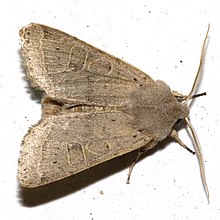| Common Quaker | |
|---|---|

| |
| Scientific classification | |
| Domain: | Eukaryota |
| Kingdom: | Animalia |
| Phylum: | Arthropoda |
| Class: | Insecta |
| Order: | Lepidoptera |
| Superfamily: | Noctuoidea |
| Family: | Noctuidae |
| Genus: | Orthosia |
| Species: | O. cerasi
|
| Binomial name | |
| Orthosia cerasi (Fabricius, 1775)
| |

(Fabricius, 1775)
The common Quaker (Orthosia cerasi) is a moth of the family Noctuidae first described by Johan Christian Fabricius in 1775. Some authors prefer the synonym Orthosia stabilis (Denis & Schiffermüller, 1775). It is distributed throughout Europe and is also found in Turkey, Israel, Transcaucasia, Russia and eastern Siberia.
This is a variable species, the ground colour of the forewings ranging from greyish to orangey brown, sometimes with a broad dark band. The most distinctive features are two large stigmata, each edged by a narrow pale line, with a similarly coloured subterminal line. The hindwings are drab grey or brown.
Technical description and variation
The wingspan is 34–40 mm. Forewing reddish grey, more or less dusted with dark: inner and outer lines blackish, indistinct; orbicular and reniform stigmata ringed with ochreous; submarginal line ochreous preceded by a fuscous or rufous shade; claviform mostly unmarked; veins towards termen pale: hindwing grey, the fringe paler. The species varies according to the amount of red present; — ab. pallida Tutt is pale grey, sometimes with an ochreous flush; — obliqua Vill. is darker grey with markings clearer; — suffusa Tutt is an equally well marked blackish-grey form; of these grey forms the second only obliqua Vill. is common; on the other hand when the red tints predominate we get the form rufa Tutt, which is also rare; - in junctus Haw. the upper stigmata, usually separate, are coherent; this accidental connection occurs in all the forms occasionally: — in ab. rufannulata Haw. the stigmata are edged with, and the submarginal line is coloured rufous instead of ochreous.[1]
Biology
This moth flies at night in March and April[1] and is attracted to light and sugar.
Larva green thickly dotted with yellowish white; all the lines yellowish white; anal segment with a yellowish-white cross bar; head green with black spots. It feeds on various trees and shrubs including apple, buckthorn, elm, oak, pear, poplar and willow as well as various Prunus species.[2] The species overwinters as a pupa.
- ^ The flight season refers to the British Isles. This may vary in other parts of the range.
References
- ^ Seitz, A. Ed., 1914 Die Großschmetterlinge der Erde, Verlag Alfred Kernen, Stuttgart Band 3: Abt. 1, Die Großschmetterlinge des palaearktischen Faunengebietes, Die palaearktischen eulenartigen Nachtfalter, 1914
- ^ Robinson, Gaden S.; Ackery, Phillip R.; Kitching, Ian J.; Beccaloni, George W.; Hernández, Luis M. (2010). "Search the database - introduction and help". HOSTS - A Database of the World's Lepidopteran Hostplants. Natural History Museum, London.
- Chinery, Michael (1986, reprinted 1991). Collins Guide to the Insects of Britain and Western Europe.
- Skinner, Bernard (1984). The Colour Identification Guide to Moths of the British Isles.
External links
- Kimber, Ian. "73.244 BF2187 Common Quaker Orthosia cerasi (Fabricius, 1775)". UKMoths. Retrieved 29 June 2019.
- Savela, Markku. "Orthosia cerasi (Fabricius, 1775)". Lepidoptera and Some Other Life Forms. Retrieved 29 June 2019. Taxonomy
- Lepiforum e.V.
- De Vlinderstichting (in Dutch)








